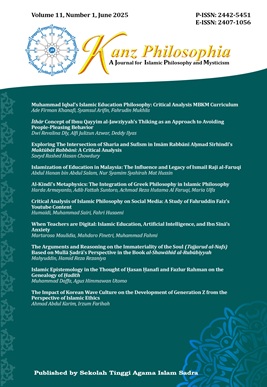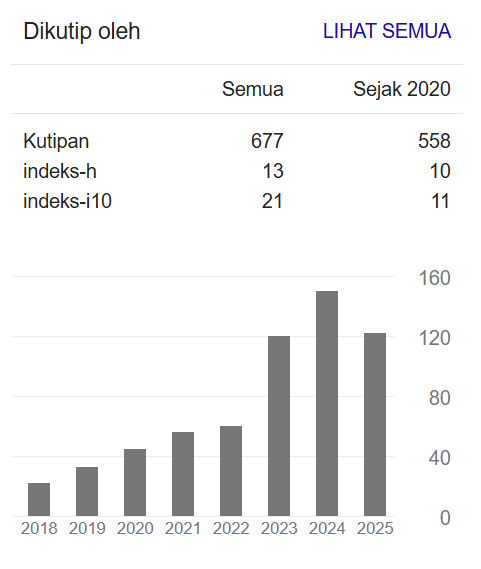EXPLORING THE INTERSECTION OF SHARIA AND SUFISM IN IMĀM RABBĀNĪ AḤMAD SIRHINDĪ’S MAKTŪBĀT RABBĀNĪ
A CRITICAL ANALYSIS
DOI:
https://doi.org/10.20871/kpjipm.v11i1.409Keywords:
Imām Rabbānī, Maktūbāt Rabbānī, Sharia, Spiritual Journey in Islam, TasawwufAbstract
This study critically examines the relationship between sufism (tasawwuf) and sharia, with a particular focus on the writings of Imām Rabbānī Aḥmad Sirhindī as articulated in Maktūbāt Rabbānī. While specific Islamic reformist movements posit a fundamental dichotomy between these two domains, Sirhindī contends that sufism and sharia are inseparable, with the former serving as an extension of the latter. This research seeks to analyze Sirhindī’s reconciliation of Islam’s mystical and legal dimensions, demonstrating that proper spiritual purification must occur within the framework of sharia rather than in opposition to it. Methodologically, this study employs a qualitative approach, utilizing textual analysis of Maktūbāt Rabbānī, particularly its first three volumes—to explore Sirhindī’s discourse on the necessity of legal adherence in the spiritual journey. The research also engages in comparative analysis with the works of Ibn al-‘Arabī, al-Ḥallāj, and al-Ghazālī to contextualize Sirhindī’s position within broader sufi thought. The findings reveal that Sirhindī’s model of tasawwuf is rooted in doctrinal orthodoxy, critiquing mystical deviations that detach spirituality from religious law. The study concludes that Sirhindī’s work offers a systematic framework for understanding sufism within Islamic jurisprudence, challenging perspectives that perceive a dichotomy between mystical practice and legal adherence. By addressing contemporary misconceptions, this research contributes to ongoing debates on the role of spirituality in Islamic law, reaffirming Maktūbāt Rabbānī as a seminal text in the discourse on the harmonious integration of sharia and tasawwuf.
Downloads
References
Afīfī, Abū al-A‘lā. 1975. The Mystical Philosophy of Muḥyī al-Dīn Ibn al-‘Arabī (Muḥyiddīn Ibn ‘Arabī’nin Taṣawwuf Falsafesi). Translated by Meḥmet Dāgh. Ankara: AÜİFY.
Ansari, Muhammad Abdu’l-Haq. 1986. Sufism and Shari’ah: A Study of Shaykh Ahmad Sirhindi’s Effort to Reform Sufism. London: Islamic Society.
Aslonovich, Muradov Sanjar. 2024. “Sheikh Ahmad Sirhindi and His Basic Ideas.” Journal of International Scientific Research 1 (3): 67–83.
Bajwa, Amna Ulfat. 2025. “Philosophical Dialogues: Jalaludin Muhammad Akbar (d. 1605)’s Universalism and Sheikh Ahmad Sirhindi (d. 1624)’s Sufi Reformation.” Journal of Applied Linguistics and TESOL (JALT) 8 (2): 481–91.
Bilgin, İbrahim Ethem. 1989. Devrimci Sûfî Haraketleri ve İmam-ı Rabbânî. İstanbul: Kültür Basın Yayın Birliği.
Bisati, Afroz Ahmad. 2001. “Sheikh Ahmad Sirhindi’s Thought and Its Impact on the Development of Sufism.” Dissertation, Srinagar: University of Kashmir.
Buehler, Arthur F. 2011. “Aḥmad Sirhindi: A 21st-Century Update.” Der Islam 86 (1): 122–41.
Cebecioğlu, Ethem. 1999. İmam-ı Rabbani Hareketi ve Tesirleri. Istanbul: Erkam Yayınları.
———. 2013. Tasavvuf Tarihi: İmam-I Rabbânî ve Vahdet-i Şuhûd Anlayışı. Ankara: Ankara Üniversitesi Uzak Tan Eğitim Yayınları.
Chowdury, Saeyd Rashed Hasan. 2024a. “Shah Wali Allah Al-Dihlawi and the Conclusive Argument from God.” Jurnal Iman dan Spiritualitas 4 (3): 267–70. https://doi.org/10.15575/jis.v4i3.38080.
———. 2024b. “The Influence of Sufi-Centric Movements on the Flourishing of Islamic Plurality in the Indian Subcontinent.” Afkar: Jurnal Akidah dan Pemikiran Islam 26 (2): 375–412. https://doi.org/10.22452/afkar.vol26no2.11.
Chowdury, Saeyd Rashed Hasan, and Vahit Göktaş. 2021. “A Critical Analysis of Imam Rabbani Ahmad Sirhindi’s Doctrines on Sufism.” Teosofi: Jurnal Tasawuf dan Pemikiran Islam 11 (1): 93–121. https://doi.org/10.15642/teosofi.2021.11.1.93-121.
Dajani, Samer. 2023. Sufis and Sharīʻa: The Forgotten School of Mercy. Edinburgh: Edinburgh University Press.
Dickson, William Rory. 2022. “Sufism and Shari‘a: Contextualizing Contemporary Sufi Expressions.” Religions 13 (5): 449. https://doi.org/10.3390/rel13050449.
Elmi, Ghorban, Marziyeh Baghestani, and Ma`soomeh Fathi. 2015. “Gnostic Exploration in Shaikh Ahmad Sirhindi’s Thought.” Journal of Subcontinent Researches 7 (25): 45–68. https://doi.org/10.22111/jsr.2015.2410.
Ernst, Carl W. 2009. “The Daily Life of a Saint, Ahmad Sirhindi, by Badr al-Din Sirhindi.” In Islam in South Asia in Practice, edited by Barbara D. Metcalf. Princeton: Princeton University Press.
Farrar, Salim. 2022. “Shariah-Based Sufism in the Modern Era: A Look at the Work of Shaykh Abdullah bin Bayyah.” Malaysian Journal of Syariah and Law 10 (2): 49–60. https://doi.org/10.33102/mjsl.vol10no2.404.
Faruque, Muhammad U. 2016. “Sufism contra Shariah? Shāh Walī Allāh’s Metaphysics of Waḥdat al-Wujūd.” Journal of Sufi Studies 5 (1): 27–57.
Firdaus, Muhammad Anang, and Rahmawansyah Sahib. 2021. “Wahdat Al-Syuhud: Ahmad Sirhindi’s Criticism on The Concept of Wahdat Al-Wujud Ibn ’Arabi.” Millati: Journal of Islamic Studies and Humanities 6 (2): 209–24. https://doi.org/10.18326/mlt.v6i2.5962.
Friedmann, Yohanan. 1966. “Shaykh Ahmad Sirhindi.” Dissertation, Montreal: McGill University.
Haksever, Ahmet. 2015. “The Introspective Criticism in Maktūbāt of Imam Rabbani Ahmad Faroq Al-Sarhandi.” Hitit Journal of Social Sciences 7 (2): 197–206.
Islam, Arshad. 2014. “Shaykh Ahmad Sirhindi (971/1564-1034/1624): A Socio Religious Reformer of Mughal India.” In 23rd International Conference of Historians of Asia 2014 (IAHA2014), 118–25. Alor Setar, Kedah, Malaysia. http://www.iaha2014.uum.edu.my/.
Kılıç, Cevdet. 2017. “For Modern-Day Sufism Discussions Analyses by Imam Rabbani.” AKADEMIAR 2 (2): 55–98.
Mesbahi, Seyyed Shahabeddin. 2014. “Revealed Grace: The Juristic Sufism of Ahmad Sirhindi (1564–1624) By Arthur F. Buehler.” Journal of Islamic Studies 25 (1): 60–62. https://doi.org/10.1093/jis/ett049.
Pagani, Samuela. 2014. “Revealed Grace: The Juristic Sufism of Ahmad Sirhindi (1564?1624). By Arthur F. Buehler.” Journal of the American Oriental Society 134 (4): 736–38. https://doi.org/10.7817/jameroriesoci.134.4.736.
Rabbānī, Imām-i. 2014. Mektubat-ı Rabbani'de Şeriat ve Tasavvuf. Translated by Necdet Tosun, Süleyman Derin, and Ahmed Hamdi Yıldırım. Istanbul: Altinoluk Erkam Publication.
Sabir, Iqbal. 2023. “Formation of Naqshbandi Mysticism Studying the Major Writings of Shaikh Ahmad Sirhindi.” In Sufism in Punjab: Mystics, Literature and Shrines, edited by Surinder Singh and Gaur Ishwar Dayal. London: Routledge.
Schimmel, Annemarie. 1973. “The Sufi Ideas of Shaykh Ahmad Sirhindi.” Die Welt des Islams 14 (1/4): 199–203.
Siddique, A. F. M. Abu Bakar. 2011. Shaikh Ahmad Sirhindi (Rh.) & His Reforms. Dhaka: Research & Publication Khanka-e Mujaddidia.
Tosun, Necdet. 2005. İmam-ı Rabbani Ahmed Sirhindi. İstanbul: Insān Publication.
———. 2020. “İmâm-I Rabbânî’nin Tasavvufî Görüşleri: Tasavvuf Yoluna Giriş ve Zikir.” Somuncu Baba Dergisi, 2020. https://www.somuncubaba.net/makale/imam-i-rabbaninin-tasavvufi-gorusleri-tasavvuf-yoluna-giris-ve-zikir.
Yıldız, Abdulvahap. 2020. “Some Common Ideas Between Bediuzzaman Said Nursî and Imam-i Rabbani.” Köprü 145: 5–22.
Ziad, Waleed. 2012. “Revealed Grace: The Juristic Sufism of Ahmad Sirhindi (1564–1624).” Der Islam 89 (1/2): 188.
Downloads
Published
How to Cite
Issue
Section
License
Copyright (c) 2025 Saeyd Rashed Hasan Chowdury

This work is licensed under a Creative Commons Attribution 4.0 International License.





























